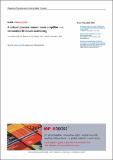Files in this item
A robust plasma-based laser amplifier via stimulated Brillouin scattering
Item metadata
| dc.contributor.author | Alves, E | |
| dc.contributor.author | Trines, Raoul | |
| dc.contributor.author | Humphrey, Katherine | |
| dc.contributor.author | Bingham, Robert | |
| dc.contributor.author | Cairns, R Alan | |
| dc.contributor.author | Fiuza, F | |
| dc.contributor.author | Fonseca, R | |
| dc.contributor.author | Silva, Luis | |
| dc.date.accessioned | 2021-10-14T15:30:02Z | |
| dc.date.available | 2021-10-14T15:30:02Z | |
| dc.date.issued | 2021-11 | |
| dc.identifier | 276252785 | |
| dc.identifier | 97b96299-b59b-46ff-9c81-d66244e6a335 | |
| dc.identifier | 85117685357 | |
| dc.identifier | 000706479600001 | |
| dc.identifier.citation | Alves , E , Trines , R , Humphrey , K , Bingham , R , Cairns , R A , Fiuza , F , Fonseca , R & Silva , L 2021 , ' A robust plasma-based laser amplifier via stimulated Brillouin scattering ' , Plasma Physics and Controlled Fusion , vol. 63 , no. 11 , 114004 . https://doi.org/10.1088/1361-6587/ac2613 | en |
| dc.identifier.issn | 0741-3335 | |
| dc.identifier.uri | https://hdl.handle.net/10023/24141 | |
| dc.description | This work was supported financially by STFC and EPSRC, by the European Research Council (ERC-2010-AdG Grant No. 167841), by the EUROfusion project and by FCT (Portugal) Grant No. SFRH/BD/75 558/2010. LOS acknowledges the support of the European Research Council (ERC-2015-AdG Grant No. 695088). | en |
| dc.description.abstract | Brillouin amplification in plasma is more resilient to fluctuations in the laser and plasma param- eters than Raman amplification, making it an attractive alternative to Raman amplification. In this work, we focus on high plasma densities, n0 > ncr/4, where stimulated Raman scattering is not possible and laser beam filamentation is the dominant competing process. Through analytic theory and multi-dimensional particle-in-cell simulations, we identify a parameter regime for which Brillouin amplification can be efficient while maintaining filamentation of the probe at a controlled level. We demonstrate pump-to-probe compression ratios of up to 72 and peak amplified probe fluences over 1 kJ/cm2 with ≃ 50% efficiency. High pulse quality is maintained through control of parasitic filamentation, enabling operation at large beam diameters. Provided the pump and probe pulse diameters can be increased to 1 mm, our results suggest that Brillouin amplification can be used to produce sub-picosecond pulses of petawatt power. | |
| dc.format.extent | 9 | |
| dc.format.extent | 1131770 | |
| dc.language.iso | eng | |
| dc.relation.ispartof | Plasma Physics and Controlled Fusion | en |
| dc.subject | Brillouin amplification | en |
| dc.subject | Parametric instabilities | en |
| dc.subject | Laser-plasma interactions | en |
| dc.subject | High energy density physics | en |
| dc.subject | QC Physics | en |
| dc.subject | NDAS | en |
| dc.subject | NIS | en |
| dc.subject.lcc | QC | en |
| dc.title | A robust plasma-based laser amplifier via stimulated Brillouin scattering | en |
| dc.type | Journal article | en |
| dc.contributor.institution | University of St Andrews. Applied Mathematics | en |
| dc.identifier.doi | 10.1088/1361-6587/ac2613 | |
| dc.description.status | Peer reviewed | en |
This item appears in the following Collection(s)
Items in the St Andrews Research Repository are protected by copyright, with all rights reserved, unless otherwise indicated.

